Nursing and Healthcare Leadership: Root Cause Analysis and Delegation Activities
VerifiedAdded on 2023/06/08
|9
|2350
|395
AI Summary
This article discusses root cause analysis team, delegation activities, and transformational nursing leadership style in healthcare. It also highlights the role of nurses in improving hospital quality.
Contribute Materials
Your contribution can guide someone’s learning journey. Share your
documents today.
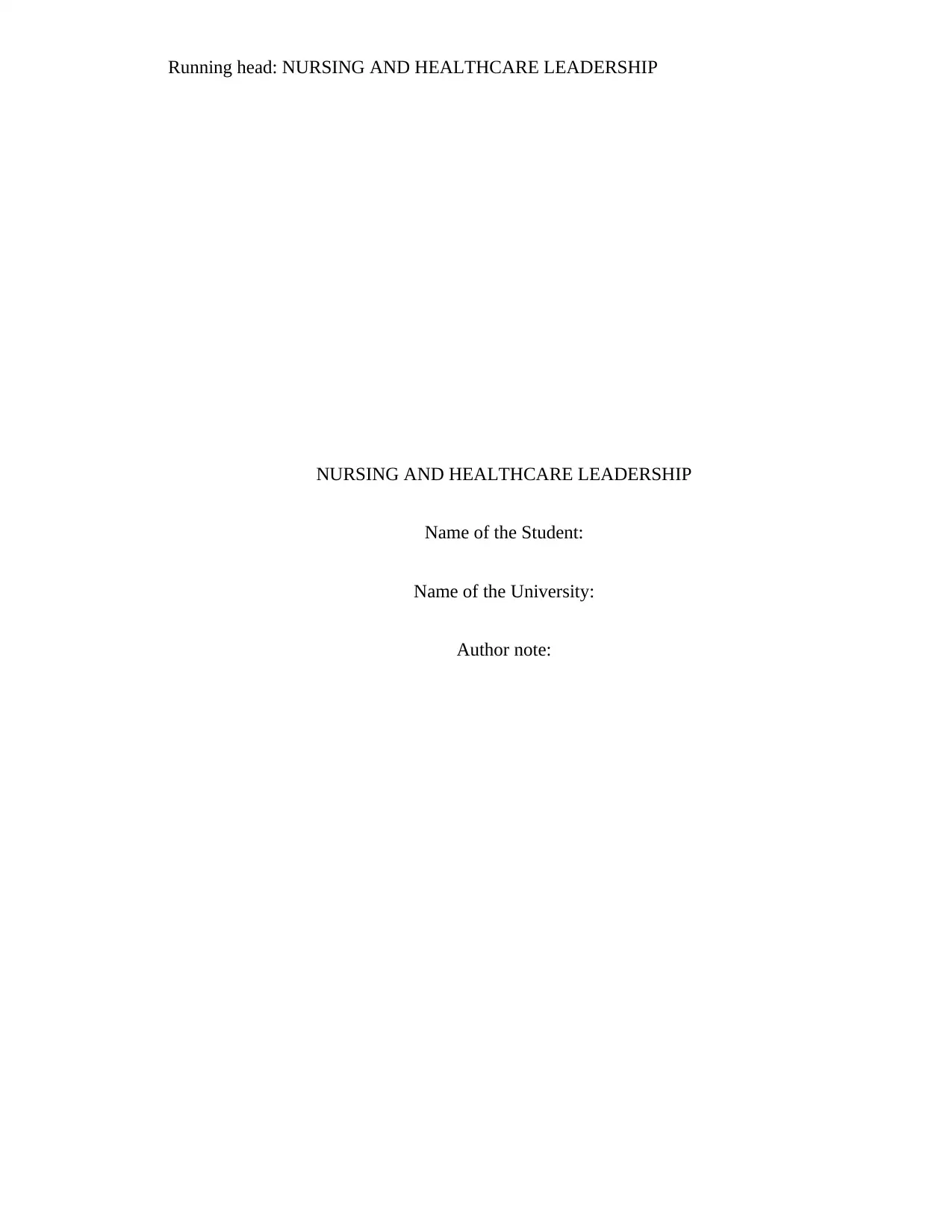
Running head: NURSING AND HEALTHCARE LEADERSHIP
NURSING AND HEALTHCARE LEADERSHIP
Name of the Student:
Name of the University:
Author note:
NURSING AND HEALTHCARE LEADERSHIP
Name of the Student:
Name of the University:
Author note:
Secure Best Marks with AI Grader
Need help grading? Try our AI Grader for instant feedback on your assignments.

1NURSING AND HEALTHCARE LEADERSHIP
Assignment 1
The root cause analysis team comprises of a risk manager, the nurse and the
pharmaceutical head. The nurse can contribute knowledge about institutional medication policies
of the hospital and patient treatment details (Hayes et al., 2016). The pharmaceutical head can
contribute knowledge about storage, availability, composition and mechanism of action of each
drug (Wang et al., 2015). The risk manager can contribute knowledge about patient health risks
of incorrect medication administration along with rapid mitigation in case of error repetition
(Nanji et al., 2016).
A team collaboration approach was adopted which includes clarified communication,
establishment of trust, specification of roles, balancing of activities and working towards a
common goal fulfillment of the organization (Weaver, Dy & Rosen, 2014). In this case, evidence
of collaboration and avoidance of blaming can be observed in the preparation of a process flow
chart along with the creation of a root cause analysis team.
The two processes which were not contributing to problem solution included usage of
nursing online documentation and computerized physician order entry. This is due to the fact that
electronic health records are often met with considerable shortcomings such as reduced patient
interaction, clinical oversight, difficult computer interface, lack of experiences, burnout and
typing errors along with lack of consideration of individual patient needs. These factors often
lead to medication errors (Schiff et al., 2015).
One of the performance improvement charts presented in this case is a Pareto Chart. A
Pareto Chart has been identified as one of the best evaluation methods for the management of
Assignment 1
The root cause analysis team comprises of a risk manager, the nurse and the
pharmaceutical head. The nurse can contribute knowledge about institutional medication policies
of the hospital and patient treatment details (Hayes et al., 2016). The pharmaceutical head can
contribute knowledge about storage, availability, composition and mechanism of action of each
drug (Wang et al., 2015). The risk manager can contribute knowledge about patient health risks
of incorrect medication administration along with rapid mitigation in case of error repetition
(Nanji et al., 2016).
A team collaboration approach was adopted which includes clarified communication,
establishment of trust, specification of roles, balancing of activities and working towards a
common goal fulfillment of the organization (Weaver, Dy & Rosen, 2014). In this case, evidence
of collaboration and avoidance of blaming can be observed in the preparation of a process flow
chart along with the creation of a root cause analysis team.
The two processes which were not contributing to problem solution included usage of
nursing online documentation and computerized physician order entry. This is due to the fact that
electronic health records are often met with considerable shortcomings such as reduced patient
interaction, clinical oversight, difficult computer interface, lack of experiences, burnout and
typing errors along with lack of consideration of individual patient needs. These factors often
lead to medication errors (Schiff et al., 2015).
One of the performance improvement charts presented in this case is a Pareto Chart. A
Pareto Chart has been identified as one of the best evaluation methods for the management of
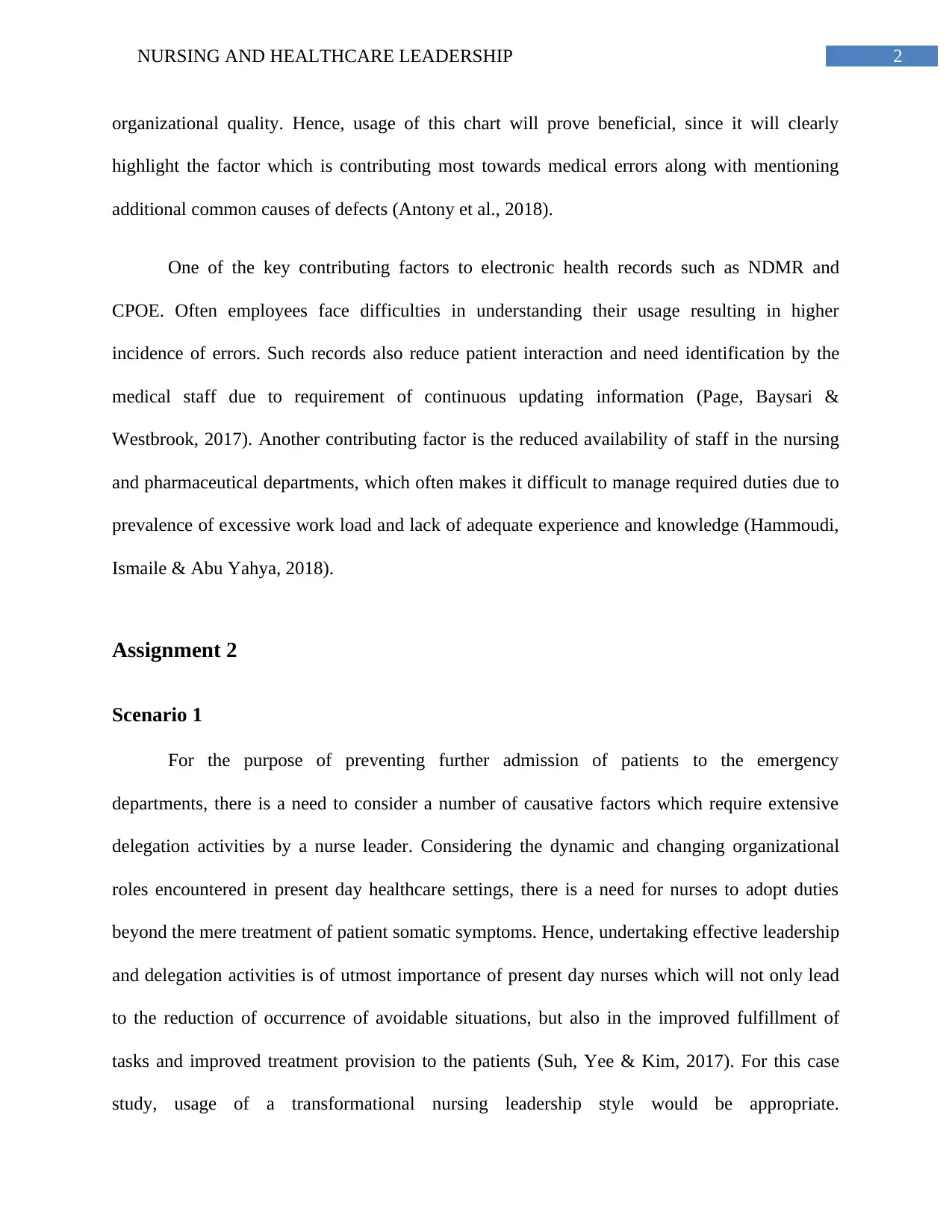
2NURSING AND HEALTHCARE LEADERSHIP
organizational quality. Hence, usage of this chart will prove beneficial, since it will clearly
highlight the factor which is contributing most towards medical errors along with mentioning
additional common causes of defects (Antony et al., 2018).
One of the key contributing factors to electronic health records such as NDMR and
CPOE. Often employees face difficulties in understanding their usage resulting in higher
incidence of errors. Such records also reduce patient interaction and need identification by the
medical staff due to requirement of continuous updating information (Page, Baysari &
Westbrook, 2017). Another contributing factor is the reduced availability of staff in the nursing
and pharmaceutical departments, which often makes it difficult to manage required duties due to
prevalence of excessive work load and lack of adequate experience and knowledge (Hammoudi,
Ismaile & Abu Yahya, 2018).
Assignment 2
Scenario 1
For the purpose of preventing further admission of patients to the emergency
departments, there is a need to consider a number of causative factors which require extensive
delegation activities by a nurse leader. Considering the dynamic and changing organizational
roles encountered in present day healthcare settings, there is a need for nurses to adopt duties
beyond the mere treatment of patient somatic symptoms. Hence, undertaking effective leadership
and delegation activities is of utmost importance of present day nurses which will not only lead
to the reduction of occurrence of avoidable situations, but also in the improved fulfillment of
tasks and improved treatment provision to the patients (Suh, Yee & Kim, 2017). For this case
study, usage of a transformational nursing leadership style would be appropriate.
organizational quality. Hence, usage of this chart will prove beneficial, since it will clearly
highlight the factor which is contributing most towards medical errors along with mentioning
additional common causes of defects (Antony et al., 2018).
One of the key contributing factors to electronic health records such as NDMR and
CPOE. Often employees face difficulties in understanding their usage resulting in higher
incidence of errors. Such records also reduce patient interaction and need identification by the
medical staff due to requirement of continuous updating information (Page, Baysari &
Westbrook, 2017). Another contributing factor is the reduced availability of staff in the nursing
and pharmaceutical departments, which often makes it difficult to manage required duties due to
prevalence of excessive work load and lack of adequate experience and knowledge (Hammoudi,
Ismaile & Abu Yahya, 2018).
Assignment 2
Scenario 1
For the purpose of preventing further admission of patients to the emergency
departments, there is a need to consider a number of causative factors which require extensive
delegation activities by a nurse leader. Considering the dynamic and changing organizational
roles encountered in present day healthcare settings, there is a need for nurses to adopt duties
beyond the mere treatment of patient somatic symptoms. Hence, undertaking effective leadership
and delegation activities is of utmost importance of present day nurses which will not only lead
to the reduction of occurrence of avoidable situations, but also in the improved fulfillment of
tasks and improved treatment provision to the patients (Suh, Yee & Kim, 2017). For this case
study, usage of a transformational nursing leadership style would be appropriate.
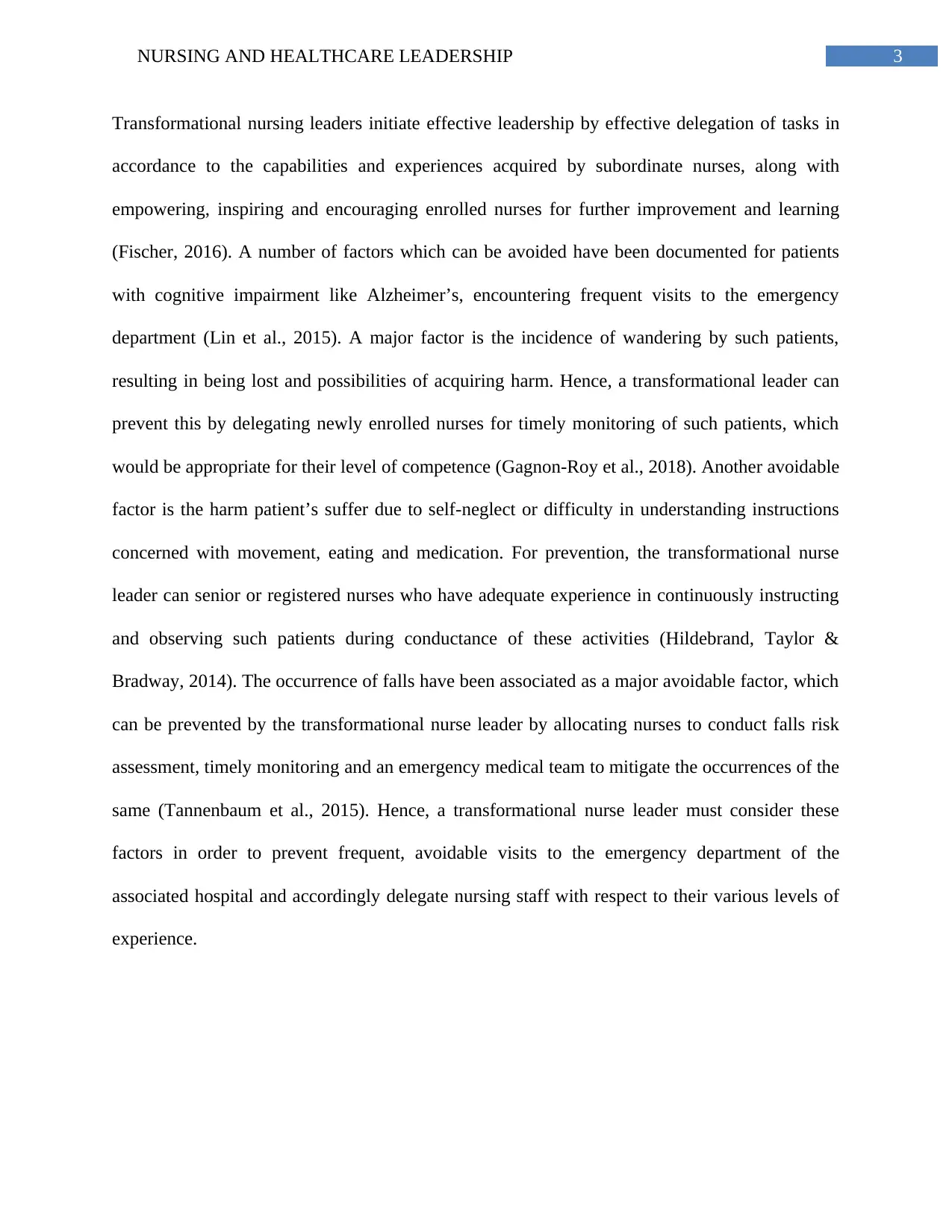
3NURSING AND HEALTHCARE LEADERSHIP
Transformational nursing leaders initiate effective leadership by effective delegation of tasks in
accordance to the capabilities and experiences acquired by subordinate nurses, along with
empowering, inspiring and encouraging enrolled nurses for further improvement and learning
(Fischer, 2016). A number of factors which can be avoided have been documented for patients
with cognitive impairment like Alzheimer’s, encountering frequent visits to the emergency
department (Lin et al., 2015). A major factor is the incidence of wandering by such patients,
resulting in being lost and possibilities of acquiring harm. Hence, a transformational leader can
prevent this by delegating newly enrolled nurses for timely monitoring of such patients, which
would be appropriate for their level of competence (Gagnon-Roy et al., 2018). Another avoidable
factor is the harm patient’s suffer due to self-neglect or difficulty in understanding instructions
concerned with movement, eating and medication. For prevention, the transformational nurse
leader can senior or registered nurses who have adequate experience in continuously instructing
and observing such patients during conductance of these activities (Hildebrand, Taylor &
Bradway, 2014). The occurrence of falls have been associated as a major avoidable factor, which
can be prevented by the transformational nurse leader by allocating nurses to conduct falls risk
assessment, timely monitoring and an emergency medical team to mitigate the occurrences of the
same (Tannenbaum et al., 2015). Hence, a transformational nurse leader must consider these
factors in order to prevent frequent, avoidable visits to the emergency department of the
associated hospital and accordingly delegate nursing staff with respect to their various levels of
experience.
Transformational nursing leaders initiate effective leadership by effective delegation of tasks in
accordance to the capabilities and experiences acquired by subordinate nurses, along with
empowering, inspiring and encouraging enrolled nurses for further improvement and learning
(Fischer, 2016). A number of factors which can be avoided have been documented for patients
with cognitive impairment like Alzheimer’s, encountering frequent visits to the emergency
department (Lin et al., 2015). A major factor is the incidence of wandering by such patients,
resulting in being lost and possibilities of acquiring harm. Hence, a transformational leader can
prevent this by delegating newly enrolled nurses for timely monitoring of such patients, which
would be appropriate for their level of competence (Gagnon-Roy et al., 2018). Another avoidable
factor is the harm patient’s suffer due to self-neglect or difficulty in understanding instructions
concerned with movement, eating and medication. For prevention, the transformational nurse
leader can senior or registered nurses who have adequate experience in continuously instructing
and observing such patients during conductance of these activities (Hildebrand, Taylor &
Bradway, 2014). The occurrence of falls have been associated as a major avoidable factor, which
can be prevented by the transformational nurse leader by allocating nurses to conduct falls risk
assessment, timely monitoring and an emergency medical team to mitigate the occurrences of the
same (Tannenbaum et al., 2015). Hence, a transformational nurse leader must consider these
factors in order to prevent frequent, avoidable visits to the emergency department of the
associated hospital and accordingly delegate nursing staff with respect to their various levels of
experience.
Secure Best Marks with AI Grader
Need help grading? Try our AI Grader for instant feedback on your assignments.
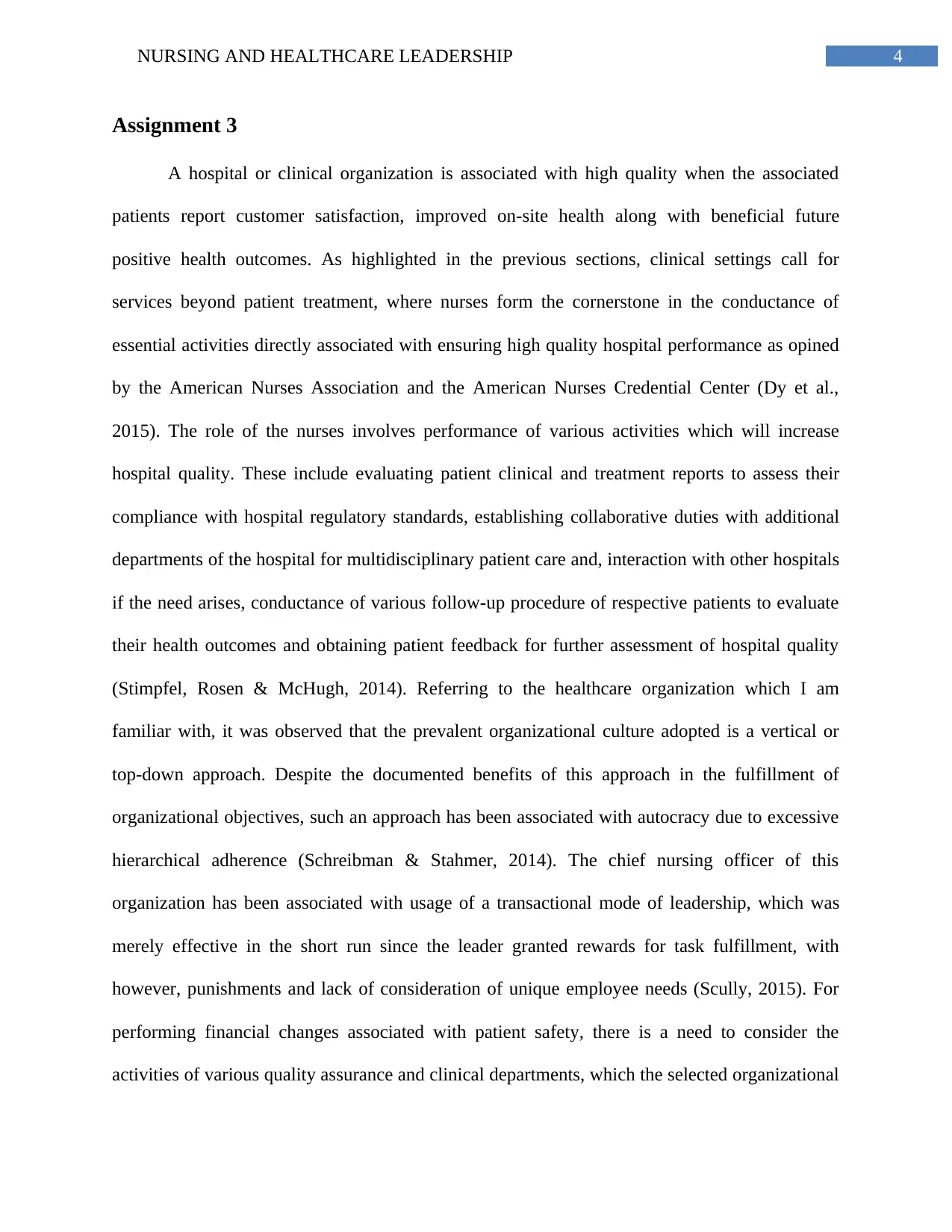
4NURSING AND HEALTHCARE LEADERSHIP
Assignment 3
A hospital or clinical organization is associated with high quality when the associated
patients report customer satisfaction, improved on-site health along with beneficial future
positive health outcomes. As highlighted in the previous sections, clinical settings call for
services beyond patient treatment, where nurses form the cornerstone in the conductance of
essential activities directly associated with ensuring high quality hospital performance as opined
by the American Nurses Association and the American Nurses Credential Center (Dy et al.,
2015). The role of the nurses involves performance of various activities which will increase
hospital quality. These include evaluating patient clinical and treatment reports to assess their
compliance with hospital regulatory standards, establishing collaborative duties with additional
departments of the hospital for multidisciplinary patient care and, interaction with other hospitals
if the need arises, conductance of various follow-up procedure of respective patients to evaluate
their health outcomes and obtaining patient feedback for further assessment of hospital quality
(Stimpfel, Rosen & McHugh, 2014). Referring to the healthcare organization which I am
familiar with, it was observed that the prevalent organizational culture adopted is a vertical or
top-down approach. Despite the documented benefits of this approach in the fulfillment of
organizational objectives, such an approach has been associated with autocracy due to excessive
hierarchical adherence (Schreibman & Stahmer, 2014). The chief nursing officer of this
organization has been associated with usage of a transactional mode of leadership, which was
merely effective in the short run since the leader granted rewards for task fulfillment, with
however, punishments and lack of consideration of unique employee needs (Scully, 2015). For
performing financial changes associated with patient safety, there is a need to consider the
activities of various quality assurance and clinical departments, which the selected organizational
Assignment 3
A hospital or clinical organization is associated with high quality when the associated
patients report customer satisfaction, improved on-site health along with beneficial future
positive health outcomes. As highlighted in the previous sections, clinical settings call for
services beyond patient treatment, where nurses form the cornerstone in the conductance of
essential activities directly associated with ensuring high quality hospital performance as opined
by the American Nurses Association and the American Nurses Credential Center (Dy et al.,
2015). The role of the nurses involves performance of various activities which will increase
hospital quality. These include evaluating patient clinical and treatment reports to assess their
compliance with hospital regulatory standards, establishing collaborative duties with additional
departments of the hospital for multidisciplinary patient care and, interaction with other hospitals
if the need arises, conductance of various follow-up procedure of respective patients to evaluate
their health outcomes and obtaining patient feedback for further assessment of hospital quality
(Stimpfel, Rosen & McHugh, 2014). Referring to the healthcare organization which I am
familiar with, it was observed that the prevalent organizational culture adopted is a vertical or
top-down approach. Despite the documented benefits of this approach in the fulfillment of
organizational objectives, such an approach has been associated with autocracy due to excessive
hierarchical adherence (Schreibman & Stahmer, 2014). The chief nursing officer of this
organization has been associated with usage of a transactional mode of leadership, which was
merely effective in the short run since the leader granted rewards for task fulfillment, with
however, punishments and lack of consideration of unique employee needs (Scully, 2015). For
performing financial changes associated with patient safety, there is a need to consider the
activities of various quality assurance and clinical departments, which the selected organizational

5NURSING AND HEALTHCARE LEADERSHIP
culture did not consider since it used a one-way, top down communication approach, considering
only the needs of the hierarchy (Manary et al., 2015). Hence, in order to transform this hospital
to a high performance once, there is a need to use transactional leadership which will inspire and
consider every employees needs, along with usage of a horizontal organizational culture since
flatter modes of communication encourages interaction amongst various hospital departments
instead of consideration of a single, autocratic hierarchy (McCleskey, 2014).
culture did not consider since it used a one-way, top down communication approach, considering
only the needs of the hierarchy (Manary et al., 2015). Hence, in order to transform this hospital
to a high performance once, there is a need to use transactional leadership which will inspire and
consider every employees needs, along with usage of a horizontal organizational culture since
flatter modes of communication encourages interaction amongst various hospital departments
instead of consideration of a single, autocratic hierarchy (McCleskey, 2014).
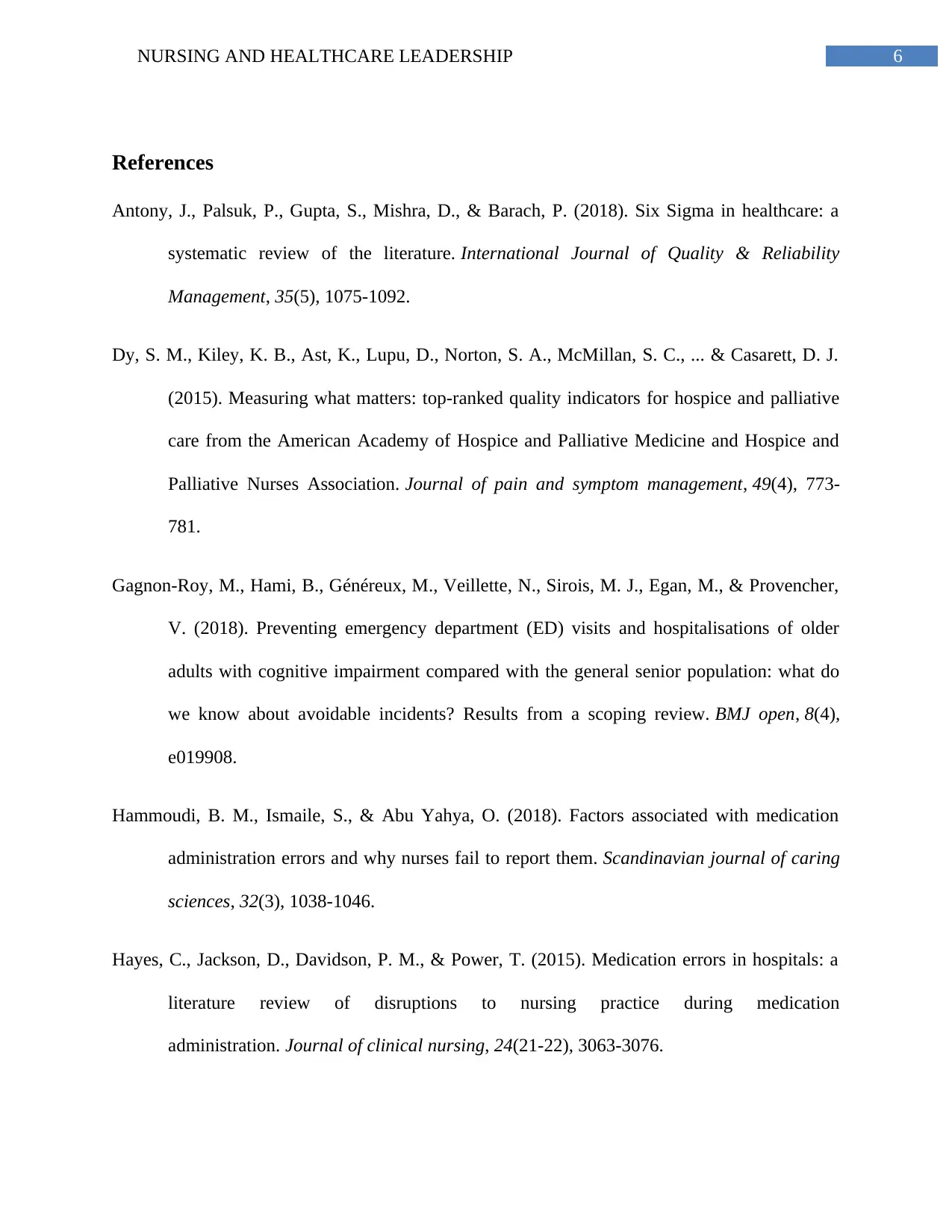
6NURSING AND HEALTHCARE LEADERSHIP
References
Antony, J., Palsuk, P., Gupta, S., Mishra, D., & Barach, P. (2018). Six Sigma in healthcare: a
systematic review of the literature. International Journal of Quality & Reliability
Management, 35(5), 1075-1092.
Dy, S. M., Kiley, K. B., Ast, K., Lupu, D., Norton, S. A., McMillan, S. C., ... & Casarett, D. J.
(2015). Measuring what matters: top-ranked quality indicators for hospice and palliative
care from the American Academy of Hospice and Palliative Medicine and Hospice and
Palliative Nurses Association. Journal of pain and symptom management, 49(4), 773-
781.
Gagnon-Roy, M., Hami, B., Généreux, M., Veillette, N., Sirois, M. J., Egan, M., & Provencher,
V. (2018). Preventing emergency department (ED) visits and hospitalisations of older
adults with cognitive impairment compared with the general senior population: what do
we know about avoidable incidents? Results from a scoping review. BMJ open, 8(4),
e019908.
Hammoudi, B. M., Ismaile, S., & Abu Yahya, O. (2018). Factors associated with medication
administration errors and why nurses fail to report them. Scandinavian journal of caring
sciences, 32(3), 1038-1046.
Hayes, C., Jackson, D., Davidson, P. M., & Power, T. (2015). Medication errors in hospitals: a
literature review of disruptions to nursing practice during medication
administration. Journal of clinical nursing, 24(21-22), 3063-3076.
References
Antony, J., Palsuk, P., Gupta, S., Mishra, D., & Barach, P. (2018). Six Sigma in healthcare: a
systematic review of the literature. International Journal of Quality & Reliability
Management, 35(5), 1075-1092.
Dy, S. M., Kiley, K. B., Ast, K., Lupu, D., Norton, S. A., McMillan, S. C., ... & Casarett, D. J.
(2015). Measuring what matters: top-ranked quality indicators for hospice and palliative
care from the American Academy of Hospice and Palliative Medicine and Hospice and
Palliative Nurses Association. Journal of pain and symptom management, 49(4), 773-
781.
Gagnon-Roy, M., Hami, B., Généreux, M., Veillette, N., Sirois, M. J., Egan, M., & Provencher,
V. (2018). Preventing emergency department (ED) visits and hospitalisations of older
adults with cognitive impairment compared with the general senior population: what do
we know about avoidable incidents? Results from a scoping review. BMJ open, 8(4),
e019908.
Hammoudi, B. M., Ismaile, S., & Abu Yahya, O. (2018). Factors associated with medication
administration errors and why nurses fail to report them. Scandinavian journal of caring
sciences, 32(3), 1038-1046.
Hayes, C., Jackson, D., Davidson, P. M., & Power, T. (2015). Medication errors in hospitals: a
literature review of disruptions to nursing practice during medication
administration. Journal of clinical nursing, 24(21-22), 3063-3076.
Paraphrase This Document
Need a fresh take? Get an instant paraphrase of this document with our AI Paraphraser

7NURSING AND HEALTHCARE LEADERSHIP
Hildebrand, C., Taylor, M., & Bradway, C. (2014). Elder self‐neglect: The failure of coping
because of cognitive and functional impairments. Journal of the American Association of
Nurse Practitioners, 26(8), 452-462.
Lin, W. C., Bharel, M., Zhang, J., O’Connell, E., & Clark, R. E. (2015). Frequent emergency
department visits and hospitalizations among homeless people with Medicaid:
implications for Medicaid expansion. American journal of public health, 105(S5), S716-
S722.
Manary, M., Staelin, R., Kosel, K., Schulman, K. A., & Glickman, S. W. (2015). Organizational
characteristics and patient experiences with hospital care: A survey study of hospital
chief patient experience officers. American Journal of Medical Quality, 30(5), 432-440.
McCleskey, J. A. (2014). Situational, transformational, and transactional leadership and
leadership development. Journal of Business Studies Quarterly, 5(4), 117.
Nanji, K. C., Patel, A., Shaikh, S., Seger, D. L., & Bates, D. W. (2016). Evaluation of
perioperative medication errors and adverse drug events. Anesthesiology: The Journal of
the American Society of Anesthesiologists, 124(1), 25-34.
Page, N., Baysari, M. T., & Westbrook, J. I. (2017). A systematic review of the effectiveness of
interruptive medication prescribing alerts in hospital CPOE systems to change prescriber
behavior and improve patient safety. International journal of medical informatics, 105,
22-30.
Schiff, G. D., Amato, M. G., Eguale, T., Boehne, J. J., Wright, A., Koppel, R., ... & Bates, D. W.
(2015). Computerised physician order entry-related medication errors: analysis of
Hildebrand, C., Taylor, M., & Bradway, C. (2014). Elder self‐neglect: The failure of coping
because of cognitive and functional impairments. Journal of the American Association of
Nurse Practitioners, 26(8), 452-462.
Lin, W. C., Bharel, M., Zhang, J., O’Connell, E., & Clark, R. E. (2015). Frequent emergency
department visits and hospitalizations among homeless people with Medicaid:
implications for Medicaid expansion. American journal of public health, 105(S5), S716-
S722.
Manary, M., Staelin, R., Kosel, K., Schulman, K. A., & Glickman, S. W. (2015). Organizational
characteristics and patient experiences with hospital care: A survey study of hospital
chief patient experience officers. American Journal of Medical Quality, 30(5), 432-440.
McCleskey, J. A. (2014). Situational, transformational, and transactional leadership and
leadership development. Journal of Business Studies Quarterly, 5(4), 117.
Nanji, K. C., Patel, A., Shaikh, S., Seger, D. L., & Bates, D. W. (2016). Evaluation of
perioperative medication errors and adverse drug events. Anesthesiology: The Journal of
the American Society of Anesthesiologists, 124(1), 25-34.
Page, N., Baysari, M. T., & Westbrook, J. I. (2017). A systematic review of the effectiveness of
interruptive medication prescribing alerts in hospital CPOE systems to change prescriber
behavior and improve patient safety. International journal of medical informatics, 105,
22-30.
Schiff, G. D., Amato, M. G., Eguale, T., Boehne, J. J., Wright, A., Koppel, R., ... & Bates, D. W.
(2015). Computerised physician order entry-related medication errors: analysis of
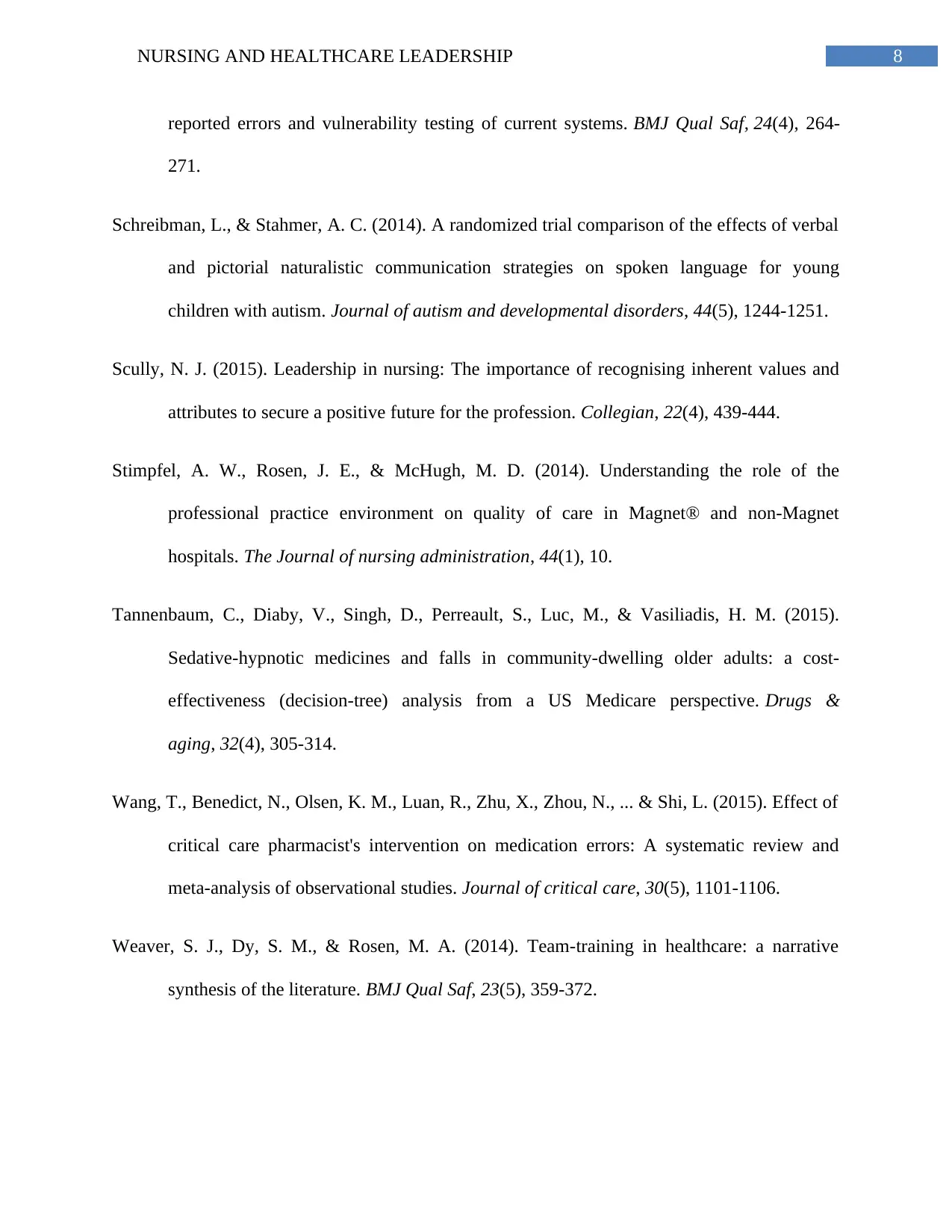
8NURSING AND HEALTHCARE LEADERSHIP
reported errors and vulnerability testing of current systems. BMJ Qual Saf, 24(4), 264-
271.
Schreibman, L., & Stahmer, A. C. (2014). A randomized trial comparison of the effects of verbal
and pictorial naturalistic communication strategies on spoken language for young
children with autism. Journal of autism and developmental disorders, 44(5), 1244-1251.
Scully, N. J. (2015). Leadership in nursing: The importance of recognising inherent values and
attributes to secure a positive future for the profession. Collegian, 22(4), 439-444.
Stimpfel, A. W., Rosen, J. E., & McHugh, M. D. (2014). Understanding the role of the
professional practice environment on quality of care in Magnet® and non-Magnet
hospitals. The Journal of nursing administration, 44(1), 10.
Tannenbaum, C., Diaby, V., Singh, D., Perreault, S., Luc, M., & Vasiliadis, H. M. (2015).
Sedative-hypnotic medicines and falls in community-dwelling older adults: a cost-
effectiveness (decision-tree) analysis from a US Medicare perspective. Drugs &
aging, 32(4), 305-314.
Wang, T., Benedict, N., Olsen, K. M., Luan, R., Zhu, X., Zhou, N., ... & Shi, L. (2015). Effect of
critical care pharmacist's intervention on medication errors: A systematic review and
meta-analysis of observational studies. Journal of critical care, 30(5), 1101-1106.
Weaver, S. J., Dy, S. M., & Rosen, M. A. (2014). Team-training in healthcare: a narrative
synthesis of the literature. BMJ Qual Saf, 23(5), 359-372.
reported errors and vulnerability testing of current systems. BMJ Qual Saf, 24(4), 264-
271.
Schreibman, L., & Stahmer, A. C. (2014). A randomized trial comparison of the effects of verbal
and pictorial naturalistic communication strategies on spoken language for young
children with autism. Journal of autism and developmental disorders, 44(5), 1244-1251.
Scully, N. J. (2015). Leadership in nursing: The importance of recognising inherent values and
attributes to secure a positive future for the profession. Collegian, 22(4), 439-444.
Stimpfel, A. W., Rosen, J. E., & McHugh, M. D. (2014). Understanding the role of the
professional practice environment on quality of care in Magnet® and non-Magnet
hospitals. The Journal of nursing administration, 44(1), 10.
Tannenbaum, C., Diaby, V., Singh, D., Perreault, S., Luc, M., & Vasiliadis, H. M. (2015).
Sedative-hypnotic medicines and falls in community-dwelling older adults: a cost-
effectiveness (decision-tree) analysis from a US Medicare perspective. Drugs &
aging, 32(4), 305-314.
Wang, T., Benedict, N., Olsen, K. M., Luan, R., Zhu, X., Zhou, N., ... & Shi, L. (2015). Effect of
critical care pharmacist's intervention on medication errors: A systematic review and
meta-analysis of observational studies. Journal of critical care, 30(5), 1101-1106.
Weaver, S. J., Dy, S. M., & Rosen, M. A. (2014). Team-training in healthcare: a narrative
synthesis of the literature. BMJ Qual Saf, 23(5), 359-372.
1 out of 9
Related Documents
Your All-in-One AI-Powered Toolkit for Academic Success.
+13062052269
info@desklib.com
Available 24*7 on WhatsApp / Email
![[object Object]](/_next/static/media/star-bottom.7253800d.svg)
Unlock your academic potential
© 2024 | Zucol Services PVT LTD | All rights reserved.





